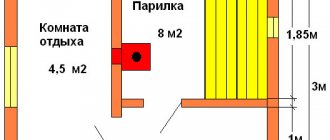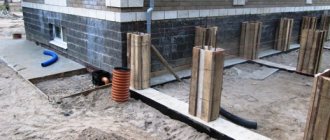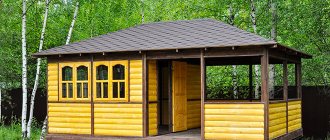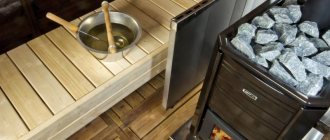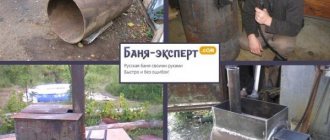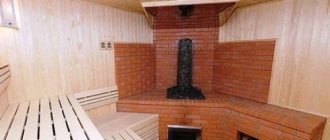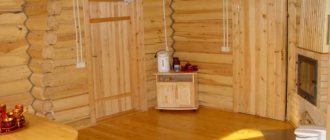Conclusions and useful video on the topic: Advantages and disadvantages of gasifying a bathhouse Before deciding to supply gas to the bathhouse, owners of suburban areas try to take into account all the features of this method. The cost of operation, environmental friendliness, difficulty of maintenance, and efficiency are taken into account. Advantages of using blue fuel In addition to noticeable savings, the advantages of this method include the hygiene of the gas - there are no odors, soot, or soot during combustion. In addition, a gasified sauna heats up almost twice as fast. Firewood is inferior to gas in many respects: it needs to be stored somewhere, monitored for timely delivery and condition. However, they are still the most popular firebox material.
Constructions
Gas furnaces generally have three main directions, they can be:
Gas sauna stoves are the second type of device (heating). The heating option is more intended for an autonomous heating system in the house and for hot water supply.
They are unable to maintain the required temperature at high humidity. The household class of devices is used for cooking and their main criterion is unpretentiousness and ease of operation, making them an indispensable assistant in the country.
In addition, gas sauna stoves are divided into groups according to the following criteria:
- material;
- burner type;
- Type of fuel;
- method of heating water.
Housing material
A stove for a gas bath can be made of stone or brick, it can also be made of metal. Each of these types of housing has pros and cons.
Stone and brick
Brick sauna stoves, although they take longer to heat up, but, unlike metal ones, retain heat much longer. In this regard, you have to start heating the steam room at night in order to steam to your heart's content during the day.
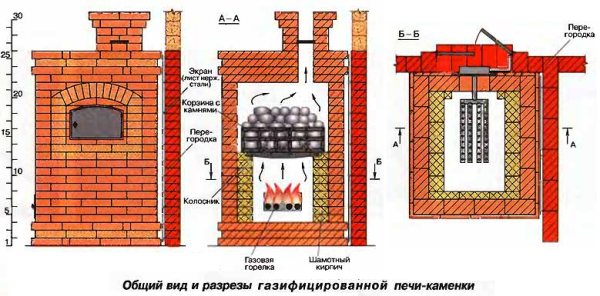
Gas fired brick stove
The appearance of this design is almost no different from a traditional wood-burning stove. Therefore, it can be built into a classic bathhouse without disturbing its harmony.
Only in this case, the “furnace” door provides access not to the place where firewood is loaded, but to the heater, which is located inside and is heated not only by the heat from gas combustion, but also by radiant energy.
Since it is placed directly above the burner, special requirements are placed on it. Bath stones should be placed in a metal trough, the bottom of which must have sides so that water does not fall on the flame.
Metal
Metal heater stoves have very thin body walls, as well as a small load of stones. Thanks to this, they warm up quickly, although they cool down just as quickly. Another advantage of the design is its compactness, which makes it possible to install the structure in any sauna or bathhouse.
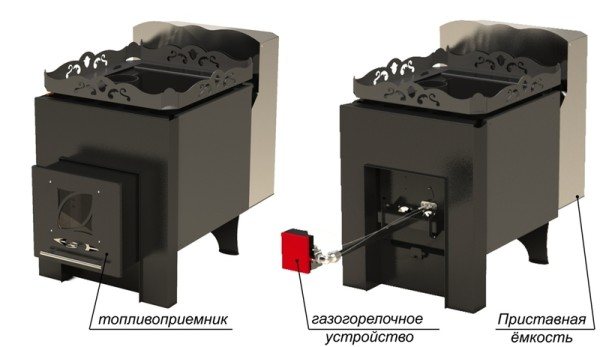
Metal stove-heater
Assembling a metal gas furnace is much cheaper. So, if you have the necessary skills and tools, you can make it yourself. Below are instructions for assembling the simplest version of a gas-powered sauna stove from a gas cylinder.
- a used gas cylinder, which can be purchased at a scrap metal collection point for nominal money;
- a used wheel rim, which will become the base of the heater. You can buy it there;
- gas pipes: two Ø 2″ – will be used to supply air and gas to the chamber, one Ø 4″ – for the chimney;
- atmospheric gas burner;
- connecting elements.
Process
- Use a grinder to cut off the top of the gas cylinder so that a wheel rim can be inserted into the hole. It is better to weld them together using electric welding, but they can also be connected with bolts.
- Prepare the air supply pipe. Drill 8-10 holes Ø 5 mm in a 2-inch pipe. Also make a hole at the bottom of the cylinder with a diameter of 52-55 mm. The second, whole part of the pipe, should extend 150-200 mm from the cylinder. Secure it with electric welding.
- Installation of the gas supply pipe is also carried out. At the second end it is necessary to make an adapter to connect the structure to a gas cylinder or gas pipeline.
- Attach the chimney to the top of the cylinder and make a door by cutting out a rectangular hole with a grinder and attaching the hinges and handle to the resulting metal piece.
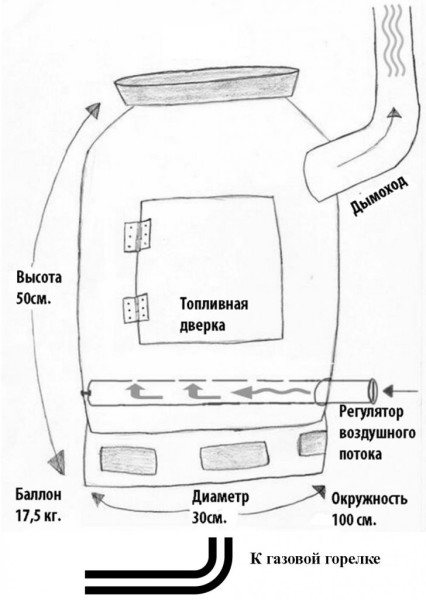
Scheme of a homemade stove from a gas cylinder
Classification by fuel type
Gas stoves can be either gas-only or combined (gas + wood), which are often called gas-wood stoves. But such versatility comes with additional costs when building a bathhouse, since the latter are large in size.
Therefore, the greatest demand today is for “clean” gas furnaces, which are more compact, lighter and safer to operate.
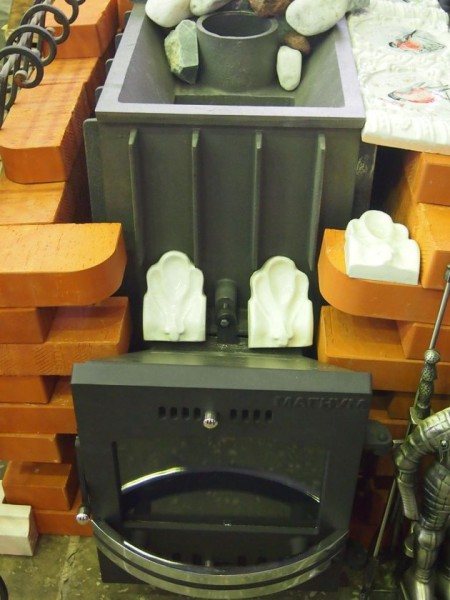
They can be connected not only to the central gas supply pipeline. The fuel can also be propane-butane, which can be purchased at regular car gas stations.
Main characteristics of gas heating in a bathhouse
It is unrealistic to imagine a suburban area without a bathhouse. There are no limits to the imagination of customers or builders when building baths. Russian steam rooms, Arab hammams, Roman baths, Finnish saunas, Japanese ofuro or sento - you just can’t find anything in the Russian expanses.
Each of these baths has its own advantages. However, there are problems that are the same for baths of any type and size, which owners have to solve individually each time when building them. First of all, it is the choice of heating type. Traditionally, the main type of baths in our country is the Russian steam room. Electricity is being used more and more today. Let's say coal, oil or gas heating in a bathhouse is still a rarity.
In many ways, the spread of such heating systems is hampered by the prevailing ideas in society about the dangers of gas as a fuel. Gas heating in a bathhouse has its own disadvantages.
Requirements
To talk about the pros and cons of a heating system, you must first determine what requirements it must satisfy.
- Safety.
- Economical.
- Ease of use.
- Warm-up speed.
Knowing the requirements listed above, you can see how gas sauna stoves meet these points.
Advantages of gas heating
- The main advantage of gas heating is its low cost. Energy prices are steadily moving upward, so cost-effectiveness considerations, even for wealthy owners, play a significant role.
- In second place, perhaps, it is worth putting the environmental safety and hygiene of gas as a fuel - there is practically no soot, no soot that would have to be removed regularly and, importantly, the gas burns odorless.
- The operation of most types of gas heating equipment is fully automated and does not require constant monitoring and intervention by the owner. In general, the need for any effort when using gas is minimal - there is no need to deliver and unload firewood, load the stove with it, etc. Therefore, gas heating is especially convenient for baths intended for a large number of users. Any experienced bathing enthusiast has a good idea of how much effort it will take to heat a steam room designed for, say, 10 people, to the required temperature.
- The heating time for a bath when using gas is minimal and even for large rooms usually does not exceed 3, maximum 4 hours.
Disadvantages of gas-type heating
- The relative complexity and high cost of the equipment in comparison with competing heating systems for baths.
- Difficulty in installing a gas heating system. Only sufficiently qualified specialists can carry it out; not everyone can do it on their own, and such a solution can result in security problems.
- The need to connect to the gas main. Not all areas of the country are gasified today. Using gas from cylinders for such purposes is not very convenient and quite expensive; they won’t last long.
- A relative disadvantage can also be considered what many consider an advantage - the lack of odor. After all, the indescribable aroma of burning wood in wood-heated bathhouses gives the bathing procedure additional chic.
The opinion that gas heating in a bathhouse is dangerous can today be considered erroneous - these systems are equipped with many safety devices and assemblies and, if the minimum operating requirements are met, are completely safe.
Gas heating of a bathhouse fulfills to a large extent the requirements for heating systems for bathhouses, subject to a number of conditions. Namely:
- If possible, connect to a centralized gas supply.
- When installing equipment by specialists of the appropriate level of qualification.
Compromise solutions
However, pure gas heating systems are not the only option for using blue fuel for heating baths.
Naturally, such systems will cost significantly more when purchased than any of their monofuel counterparts. However, the difference in price will very quickly be compensated by efficiency and convenience. After all, the owner of such a stove gets the opportunity to use for heating the type of fuel that he gets at the lowest price or the one to which he has the most free access.
Conclusion
Using gas stoves in a sauna allows you not to worry about the fuel burning in the firebox and enjoy the sauna procedures. All that remains is to choose the appropriate model and install it correctly in the steam room. In addition, we must not forget about fire safety rules and carbon monoxide. In the video presented in this article you will find additional information on this topic.
Apr 2020 22:43 And yet, Country real estate.

Cost of gas connection, documents, conditions, tariffs
To obtain technical specifications, a certain list of documents is required, namely: an application for obtaining technical specifications, a copy of the passport and documents on ownership. And if the house is only in the project - then the right to the land, a certificate of registration of ownership of the property and a plan for the location of the house. In this case, the house will be connected only if it is located no more than 200 m from the main gas main. Your application must be reviewed within 1 month.
- After submitting all necessary documentation to the gas service and drawing up a project, the technical connection is made. Gas service workers must install a gas pipe from the main line to your site. The cost of this work ranges from 25-50 thousand. It all depends on the length of the pipe and the complexity of its installation.
- The most expensive procedure is drawing up a project for gasification of a house.
Additional gas outlet (after the meter) to the neighboring house (building) on the site
Average cost for 2020 Prices for connecting gas to your home will vary depending on the location, but on average:
- Collection of primary documents (filling out an application costs from 8,000 to 50,000 rubles).
- Design work is estimated from 3,000 to 20,000 rubles.
- The construction of a pipe from the central highway to your home and the distribution of pipes along it will cost from 2,000 to 5,000 rubles per meter.
- To embed your pipe into the main one, you will have to pay from 10,000 to 15,000 rubles.
- The inspection work to check readiness for operation will cost from 1000 to 2000 rubles.
Gasification - necessary documents
The design organization also needs to provide a package of documents, which includes:
- technical specifications;
- topographical survey of the connected area with all communications, which should be developed by a specialist from a design institute or other organization;
- technical passport for the house (copy) or other permitting document for construction.
Foreign heating equipment requires certificates confirming compliance with all technical conditions, as well as inspection documents in the country of installation. Gas connection is carried out by local gas services, which remove a pipe from the general main line that goes directly to the area on which the house is located.
Is it possible to pipe gas into a non-residential building? There is no clear answer to this seemingly simple question. When writing a review article, it turned out that even experienced lawyers express opposing opinions on some aspects of the problem. The article does not pretend to be the judge of last resort. If readers have personal experience, for example, gasification of SNT, non-residential premises, or know how to legally install gas in a summer kitchen, please share the information in the comments.
Problems of arranging and connecting a gas furnace
We are talking about how to supply gas from the house to the bathhouse from an existing subscriber point of consumption of network gas fuel. Gasifying a sauna using bottled gas makes sense only for very small sauna rooms, no more than 3x3 m. In other cases, only laying a pipe with household gas fuel remains economically justified.
During the gasification process, several serious problems will have to be faced. Solving most of them will require extraordinary patience:
- Obtaining permission to gasify a bathhouse building;
- Obtaining permission to build a bathhouse in the courtyard of the house;
- Selection or development of a bathhouse project in a configuration that would allow approval of permits for gasification without problems.
In addition, you will need to find a bona fide contractor with a license that would carry out the work of laying gas pipes and installation without extra costs.
Features of gasification of non-residential premises
Let's immediately turn to the letter of the law. According to SNiP 2.04.08-87 “Gas supply” clause 6.32, it is possible to locate gas heating equipment and stoves in buildings located outside residential buildings. A permit is issued to the design organization taking into account various local factors, including paying attention to the presence of a main gas pipeline to implement such intentions. Installation of gas equipment is permitted in rooms that must meet the same criteria as rooms in residential buildings. In short, everything is at the discretion of the operating gas company. What to do? Stomp towards the organization issuing permits.
In a building under construction or in a non-residential building, connection to the main utility network is established according to an individual project on the basis of an agreement between the gas service and the owner of the building. In order for the process to move forward, the customer needs to receive technical specifications (TS). The next stage consists of the following approximate actions:
- You must submit a request for technical specifications.
- Acquisition of specifications.
- Written application for connection agreement.
- Signing the document of accession.
- Obtaining a warrant to commission the building.
- Signing the act of connection to the gas line.
In this case, the maximum hourly gas consumption should not exceed the established standards.
Legal requirements for design, equipment, installation
The basic requirements for laying gas pipes inside the bathhouse, the design of the stoves and the parameters of the room are prescribed in SNiP 2.04.08-87 .
The arrangement of an external gas pipeline and connection features are regulated by SNiP 42-01-2002 .
Conditions for approval of the project by technical supervision
It is extremely rare that bathhouse owners manage to coordinate gas wiring, since their buildings do not meet the requirements. It is more correct to first create a project and then begin construction. Moreover, the building must be located on a solid foundation.
The main criteria are the presence of an emergency exit, a transom for ventilation or an exhaust ventilation duct, and sufficient area. The volume of the room where the oven is located must be more than 8 cubic meters. And the passage next to it cannot be less than a meter wide.
Attention is also paid to the doors - each of them should open outward and have functional handles on both sides. The doors themselves can only be made of non-combustible materials. All this is taken into account when agreeing.
Equipment selection criteria
Not all types of stoves are suitable for installation in gasified baths. Only factory-made metal products are allowed, the design of which allows combustion products to be discharged into the chimney. Stone and brick-lined ovens are prohibited. Important points are the presence of a fuse that blocks the supply of fuel when the fire dies out and the tightness of the gas chamber.
It is worth noting that leading Russian manufacturers, such as Ermak , Termofor , Teplodar, produce approved models with excellent automation and high-quality components. While the products of European factories do not always successfully pass testing.
The stove should be serviced not in the steam room, but in the dressing room. Therefore, the design must have an external fuel channel.
Particular attention is paid to the type of jets: when using a main gas supply, expanded nozzles are required, while when using a propane mixture from a cylinder, narrowed nozzles are required.
Rules for installing a gas pipeline, stove, chimney
The installation rules include requirements not only for laying a gas pipeline, but also for installing a fire alarm. Highly sensitive carbon monoxide sensors can play this role.
The pipe outlet from the house should rise 2 meters above ground level and enter the dressing room at the same height. Laying under or inside the foundation is prohibited.
A valve is installed at the end of the pipe, which, in the event of depressurization of the equipment, will immediately ensure complete shutoff of the gas pipeline.
Particular attention is paid to the placement of furnaces. Wooden walls next to them must be insulated with non-combustible materials. An acceptable option is sheathing with thermal insulation and steel sheets.
The fireproof distance from the insulated wall to the product body is 60 cm. All other objects, ceilings, wall shelves must be at a distance of at least 110 cm from the walls of the stove.
The supporting base of the furnace must also be made of refractory material, protruding beyond the boundaries of the product by 10 cm or more. It is allowed to connect the stove to the chimney only with steel pipes.
The installation of the chimney itself is also regulated. In places where they pass through the ceilings and walls of the bathhouse, it is necessary to lay fire-proof cuttings.
Very often expanded clay is used for this purpose. Bulk material easily fills space and has high fire-resistant characteristics.
Procedure for obtaining technical specifications
Technical conditions for gas supply to non-residential buildings are issued by the gas service of the local region. In addition to the application, the following list of documents is required to obtain specifications for gasification:
- Documents on the ownership of the plot;
- An official document confirming the identity or competence of the representative;
- A plan of the territory on which the building is located, linked to topographic maps;
- Consent of the gas supply organization;
- Technical passport;
- Plan of non-residential premises, as well as ventilation and smoke ducts.
When issuing technical specifications, the applicant receives the following information:
- Name of the company providing the services;
- Parameters for changing pressure at the point of connection with the main gas network;
- Address and site plan;
- Gas consumption parameters (min and max values per hour);
- Description of the features of the facility and the maximum permitted volume of gas use.
If technical conditions are provided and the authorized organization refuses to connect in a timely manner, the customer has the right to go to court. You should not change your plans; there is a high probability that the judicial authorities will side with the property owner. Also, a refusal to issue technical specifications in the absence of a motivated refusal by the contractor can be challenged in the courts.
Gasification of a bathhouse in the presence of a gasified house
Conclusions and useful video on the topic: Advantages and disadvantages of gasifying a bathhouse Before deciding to supply gas to the bathhouse, owners of suburban areas try to take into account all the features of this method. The cost of operation, environmental friendliness, difficulty of maintenance, and efficiency are taken into account.
Advantages of using blue fuel In addition to noticeable savings, the advantages of this method include the hygiene of the gas - there are no odors, soot, or soot during combustion. In addition, a gasified sauna heats up almost twice as fast. Firewood is inferior to gas in many respects: it needs to be stored somewhere, monitored for timely delivery and condition.
However, they are still the most popular firebox material. And they are even used in combined gas-wood stoves. A big plus is the automation of the process. Kindling requires minimal labor on the part of the owner. Combined with the cheapness of gas, this advantage makes gasification of a bathhouse especially attractive. Disadvantages noticed by owners and professionals According to the owners, the main disadvantage is the difficulty in obtaining permission: if there is the slightest inaccuracy, the commission prohibits the use of gas to heat the bath.
Professional gas workers note a high level of danger if installation rules are not followed, there is a lack of safety devices and owners are vigilant. Other disadvantages users include: the need to pay for the work of installation specialists; high cost of equipment; restrictions on the choice of sauna design.
Another subjective observation concerns the lack of odor. Many people appreciate the aroma that spreads throughout a heated room when wood burns. Gas equipment eliminates this possibility. Legal requirements for the design, equipment, installation The basic requirements for laying gas pipes inside the bathhouse, the design of the stoves and the parameters of the room are prescribed in SNiP 2.
The arrangement of an external gas pipeline and connection features are regulated by SNiP. Conditions for approval of the project by technical supervision. It is extremely rare that bathhouse owners manage to approve gas wiring, since their buildings do not meet the requirements. It is more correct to first create a project and then begin construction. Moreover, the building must be located on a solid foundation. Old baths often have low ceilings.
Due to this parameter alone, they are not suitable for gasification. A properly designed room has a distance between the floor and ceiling of more than 2 meters. The main criteria are the presence of an emergency exit, a transom for ventilation or an exhaust ventilation duct, and sufficient area. The volume of the room where the oven is located must be more than 8 cubic meters.
And the passage next to it cannot be less than a meter wide. Attention is also paid to the doors - each of them should open outward and have functional handles on both sides. The doors themselves can only be made of non-combustible materials. All this is taken into account when agreeing. Equipment selection criteria Not all types of stoves are suitable for installation in gasified baths.
Only factory-made metal products are allowed, the design of which allows combustion products to be discharged into the chimney. Stone and brick-lined ovens are prohibited. Important points are the presence of a fuse that blocks the supply of fuel when the fire dies out and the tightness of the gas chamber. While the products of European factories do not always successfully pass testing.
When purchasing, check the quality and safety certificates, check the product passport filled out by the manufacturer. It should contain marks indicating successful completion of technical control. Maintenance of the stove should be carried out not in the steam room, but in the dressing room. Therefore, the design must have an external fuel channel.
Particular attention is paid to the type of jets: when using a main gas supply, expanded nozzles are required, while when using a propane mixture from a cylinder, narrowed nozzles are required.
Rules for installing a gas pipeline, stove, chimney Installation rules include requirements not only for laying a gas pipeline, but also for installing a fire alarm. Highly sensitive carbon monoxide sensors can play this role.
The pipe outlet from the house should rise 2 meters above ground level and enter the dressing room at the same height. Laying under or inside the foundation is prohibited. A valve is installed at the end of the pipe, which, in the event of depressurization of the equipment, will immediately ensure complete shutoff of the gas pipeline.
When choosing equipment for a bath, you should always pay attention to the permitted operating temperature. For example, many Chinese CO sensors are designed for temperatures up to 55 degrees. Particular attention is paid to the placement of furnaces. Wooden walls next to them must be insulated with non-combustible materials. An acceptable option is sheathing with thermal insulation and steel sheets.
The fireproof distance from the insulated wall to the product body is 60 cm. All other objects, ceilings, wall shelves must be at a distance of at least cm from the walls of the stove.
The supporting base of the furnace must also be made of refractory material, protruding beyond the boundaries of the product by 10 cm or more. It is allowed to connect the stove to the chimney only with steel pipes.
According to paragraph 5. Detachable connections are allowed in places where elements of gas equipment are connected. Installation of the chimney itself is also regulated. In places where they pass through the ceilings and walls of the bathhouse, it is necessary to lay fire-proof cuttings.
Very often expanded clay is used for this purpose. Bulk material easily fills space and has high fire-resistant characteristics. Completing documents and obtaining permission We have already mentioned that before starting construction it is worth checking the project and clarifying whether it is possible to supply gas to the bathhouse as intended by the owner.
If everything is in order, construction can begin. A permit to build a bathhouse is not required. It is received only if the bathhouse is registered as a garden house. Then documents are prepared to obtain consent for gasification: an application for the provision of technical conditions; passport and title documents of the owner of the site; calculation of maximum consumption in one hour; site plan or diagram; If the gas pipeline is private property, then the consent of the owner must be attached.
After the gas distribution company issues the specifications, you need to make adjustments and invite a gas service inspector. If the building complies, he will issue a permit for gas supply and an equipment layout. Since gas workers are much more willing to issue permits for gasification of residential buildings, many owners register the bathhouse in this very status. This simplifies obtaining technical specifications and speeds up the process. You can do the same with an old bathhouse already built on the site.
It is possible that to bring it into proper condition it will only be necessary to organize additional window openings and an emergency exit. True, practice shows that the percentage of obtaining permits in such cases is extremely low. The procedure for carrying out gas, practical advice The preparatory stage is the purchase of pipes, consumables and gas equipment.
To gasify a bath according to the rules, you need to check the project and the received technical conditions. The documents contain a calculation of the length of the pipes, an indication of their diameter, as well as the name and brand of permitted equipment. Experienced users advise purchasing pipes and consumables with a 30 percent reserve.
They must raise the gas pipeline above the ground by at least two meters. The following requirements are imposed on the supports: the distance between the supports is determined by the design; the strength of the structure should be calculated based on the gas pipeline’s own weight and the weight of possible ice with a coefficient of 1.2; the fastening part must correspond to the design dimensions of the pipe. If the project specifies the installation of a gas pipeline with a slope, you can install metal spacers between the soles of the supports and embedded structures.
The installation of such gaskets between the pipe and the support is prohibited. The rules for placing supports also apply to the distance between them and the welds on gas pipes. This distance cannot be less than 5 cm. To protect against the effects of wet precipitation, the outer pipeline is painted with bright yellow oil paints. This is done by employees of the gas company that took over the installation.
But after they leave, many summer residents repaint the pipes in other colors that match the main palette of the site. This is prohibited. In places where they pass through the walls, it is necessary to drill holes and install embedded iron sleeves in them. Laying pipes through walls is permitted only through such sleeves. When gasifying wooden buildings, this is extremely important, since any wood shrinks over time.
And this is fraught with damage to the unprotected gas pipeline. Holes for the gas pipeline are prohibited from being made between logs or beams, at their junction. They must be located inside solid wood. Fastening must be carried out using products specified in the project. It is better to purchase fasteners in specialized stores, since regular retail outlets often offer analogues that do not meet the requirements.
To implement turning moments, it is important to use an induction pipe bender - a device that allows you to change the angle by 90 degrees. The manual bending method with heating is not suitable in this case, as it can damage the structure of the metal. At the points where gas equipment is connected, the end of the pipe is threaded. Filters are attached to this thread and shut-off valves are installed. During the final pressure testing, a specialist must check the tightness of these connections and the integrity of the welds.
Before performing welding work, you should make sure that you have a fire extinguisher, cover the wooden walls of the bathhouse and nearby buildings with asbestos or metal sheets. It is important to ensure that the gas pipes inside the bathhouse do not intersect with the electrical wire. The minimum distance between them is 10 cm. If water supply or sewerage is installed in the bathhouse, then it is necessary to maintain a distance of 2 cm between them and the gas pipeline branch. Therefore, the next step is the organization of the chimney. Gas companies also have special requirements for it.
During installation, it is recommended to ensure: that there are no pipe joints in the ceilings - it is necessary to mount the chimney so that the connections are located above or below the ceiling; the location of the pipes relative to the flammable elements of the building - the distance between them should not be less than 1 meter.
Above a flat roof, the chimney can protrude 1.2 meters or more. Above a roof with slopes, the minimum elevation value is 0.5 meters. Conclusions and useful video on the topic Having collected information on how to properly supply gas to a bathhouse, we found out that the law imposes strict requirements on the project, equipment parameters and conditions for installing a gas pipeline.
How to install gas into a country house
It would be good if the gasification program applies to a country house located in a village that falls under this project. A garden house within the boundaries of a fairly large settlement differs from a country house. A country house and estate in a small village may very often have no communications. If the regional gasification program bypasses the locality in which the dacha plot is located, then its owner will face many obstacles. In fact, the owner can provide gas to his legal property. However, in reality there are quite a lot of nuances, especially when it comes to SNT.
Is it possible to carry gas into SNT
The answer is entirely positive. However, not everything is so smooth. Further coordination with the gas organization is associated with many complications. So what is the problem with gasification of a garden plot? Intentional action and desire to carry out gas without a meeting of members of the partnership is impossible. If the majority of property owners vote approvingly, then SNT adopts the appropriate conclusion. If more than half of the members of the partnership voted “against”, the gasification agreement is drawn up only by the owners of garden real estate who voted “for”.
Gasification methods
To provide citizens with household needs, there are two options for solving the problem. In the first, at the general meeting, the amount of payment that each member of the partnership will have to make is calculated. All gas pipeline costs are general. They are divided equally among everyone. However, a conflict arises here: those owners who refused are not exempt from the target fee, and will be forced to pay a certain amount. They will also be virtually forced to connect to the central gas main, and if they evade payment, other members of the partnership will have to seek compensation through the courts.
The second option for solving the problem in the event of a majority of members refusing to supply gas would be the creation of a PNP (consumer non-profit partnership) only by those citizens who are interested in gasifying their homes. That is, you will have to register a legal entity, and in addition to paying for gas service services, you will have to fork out money for an accountant and chairman. However, the advantage is obvious: in this case, people can decide to supply gas directly to their homes.
Next, this legal entity coordinates all documentation with the gas service, monitors the progress of work and, if necessary, can raise the issue of increasing the amount at a meeting
payment for work on laying the pipeline. The duration of connection activities is specified in the contract.
How requirements are written
How the steam rooms will be heated and what the entire building consists of should be taken into account when planning to place a sauna or bathhouse on a plot of land.
Experts in this field give recommendations that these objects should be built at a distance of 10-12 meters, provided that they are regularly heated and a lot of smoke is emitted, despite the fact that the regulatory documents indicate a shorter distance.
This point can be adjusted depending on how much free space there is on the site and the distance from the neighbors’ sites.
Requirements of SNiP 30-02-97 with changes and amendments to date:
- The distance from the residential building to the fence must be at least three meters, taking into account the proximity to the neighbor’s house and the materials of the buildings.
- Outbuildings with animals and greenhouse complexes must be located at least four meters from the fence.
A very important nuance is that smoky-type baths are not allowed to be located in densely populated areas, because one way or another it will cause inconvenience to your neighbors, who most likely will not be happy. In addition, there is a high probability of a fire.
Local administrative authorities must approve the project before construction begins. And it very often happens that citizens do not act in the required sequence, but begin to legitimize buildings after they appear, and just as often this leads to conflict situations.
If you do not deviate from the targeted instructions specified in SNiP, the owner of real estate acts on a legal basis and does not have to worry, even if the owner of a neighboring plot puts forward some claims that he intends to resolve through the court.
Gasification of the bathhouse
You can also install gas heating in the bathhouse. In principle, there are no separate laws or regulations specifically for such buildings. In addition to approvals from gas workers, the project with a fire structure will have to be approved. In any case, those who have this object officially registered as a bathhouse, and not, say, as a barn, have a greater chance of supplying gas to a bathhouse building. This is due to the general rules that are in special construction documentation.
So, for example, outbuildings with farm animals should be located no closer than 4 meters from the bathhouse. There must be at least 3 meters from the fence to the bath complex, if there is no building on the other side of the fence. Otherwise, there must be a distance from the bathhouse to the building of at least 6 meters. The distance from a wooden bathhouse to residential buildings must be at least 10 meters within the boundaries of urban settlements.
The law nowhere stipulates the nuance that an object such as a bathhouse cannot be placed inside a residential building or it is prohibited to be attached to a house. The sanitary regulations apply only to the placement of a washing room. And then only in cases where wastewater gets into the soil.
As can be seen from the examples, there are quite a lot of nuances in approving permission to gasify a bathhouse. The question of how to supply gas to the bathhouse and set up a steam room remains open. Of course, you can try, but many true broom and steam lovers still prefer natural firewood.
Gas procedure, practical advice
The preparatory stage is the purchase of pipes, consumables and gas equipment. To gasify a bath according to the rules, you need to check the project and the received technical conditions.
The documents contain a calculation of the length of the pipes, an indication of their diameter, as well as the name and brand of permitted equipment. Experienced users advise purchasing pipes and consumables with a 30 percent reserve.
Stage No. 1 - installation of an external gas pipeline
Since it is recommended to install an external gas pipeline above ground, reliable supports will be required to secure the pipes. They must raise the gas pipeline above the ground by at least two meters.
The following requirements apply to supports:
- the distance between the supports is determined by the project;
- the strength of the structure should be calculated based on the gas pipeline’s own weight and the weight of possible ice with a coefficient of 1.2;
- the fastening part must correspond to the design dimensions of the pipe.
If the project specifies the installation of a gas pipeline with a slope, you can install metal spacers between the soles of the supports and embedded structures. The installation of such gaskets between the pipe and the support is prohibited.
How to supply gas to a summer kitchen
To gasify a summer kitchen, you first need to contact the gas service to draw up a new project for gasification of the entire yard.
Note! Connecting a summer kitchen to the gas distribution network is possible in the case of a permanent construction.
Of course, in other cases you can connect unofficially, but if the gas service catches a citizen in deception, liability cannot be avoided. Therefore, it is necessary to register a capital construction project with copies of official documents attached.
Conducting gas into an unformed extension
It is almost impossible to officially supply gas to such an extension. However, if somehow the premises were previously gasified (for example, it was once an old gasified extension, and a new one was unofficially built in its place). In this case, it is necessary to make adjustments to the existing design documentation for the house. To do this, you need a schematic plan of the premises from the BTI authorities. In this case, it is necessary that the area be indicated in the plan. But in order for specialists from BTI to take measurements, you need to provide title documents for the new premises. What a bummer!
Implementation of the gasification project for the bath house
After completion of construction, the house for the bathhouse will need to be registered with the BTI and changes must be made to the house construction plan. Only after this will it be possible to go to the city gas management office and write an application for gasification of a residential premises. It is clear that according to the documents this is a guest house, not a bathhouse. Copies of documents for boiler equipment will need to be attached to the application.
As a rule, questions do not arise about why a house should be gasified, or why a powerful boiler or gas fireplace is used for such a small room. Based on the results of consideration of the application, an inspector will come to the place of gasification of the bathhouse, who will draw up an inspection report of the premises, draw a connection plan and a sketch of the possible location of the gas pipe.
